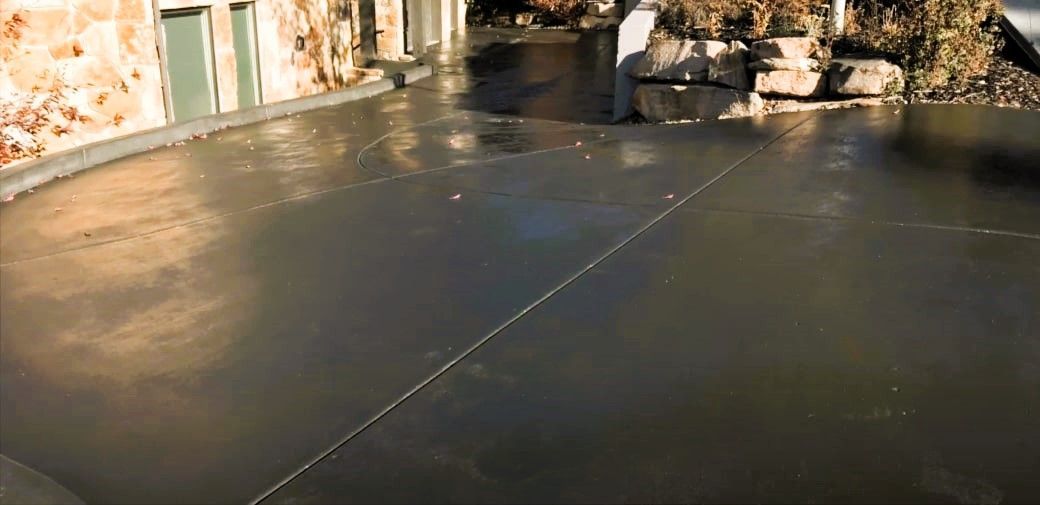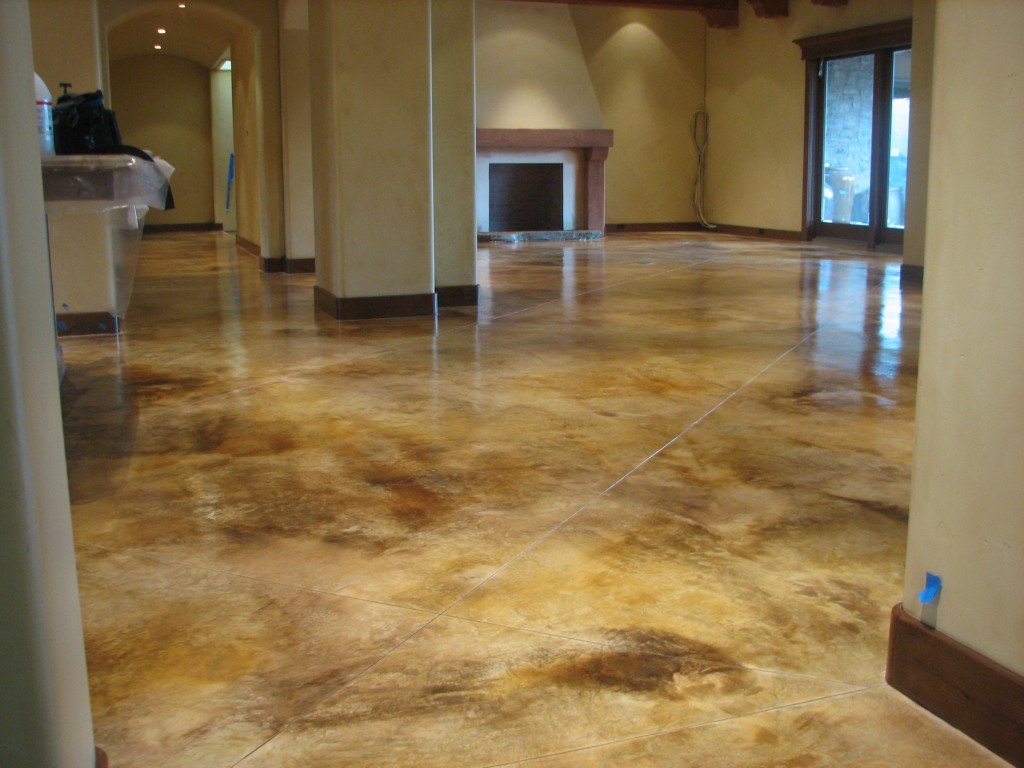A Comprehensive Guide to the Different Kinds Of Stained Polished Concrete
Stained polished concrete deals a flexible and aesthetically appealing flooring option for numerous settings. Understanding both main kinds of discolorations-- acid-based and water-based-- can greatly affect design options. Each kind gives special benefits and visual qualities. The decision-making procedure involves not simply shade choice but likewise factors to consider of resilience and maintenance. As one explores the details of these spots, vital factors enter into play that can influence the general outcome of any kind of concrete job.
Comprehending Stained Polished Concrete
While many individuals value the aesthetic charm of polished concrete, understanding stained polished concrete is crucial for appreciating its special attributes and applications. Stained polished concrete combines the longevity of polished concrete with the lively colors and patterns achieved with staining. This process improves the surface's visual allure, permitting for creative expression in different environments, from commercial rooms to domestic homes.
Stained polished concrete is versatile, supplying an array of coatings that can imitate all-natural stone or create an extra modern appearance. The stain passes through the concrete surface area, giving a durable remedy that withstands fading and wear. Furthermore, the combination of staining and polishing lead to a smooth, reflective surface area that is very easy to clean and keep.
Sorts of Stains: Acid vs. Water-Based
Stains play a vital function in the aesthetic change of polished concrete, mostly classified right into 2 types: acid-based and water-based - local stained concrete. Acid-based discolorations penetrate the concrete, responding chemically with the minerals to develop irreversible, variegated shade impacts. They use a rich, transparent coating that enhances the natural texture of the concrete, making them a popular selection for attaining an extra natural look. The application process is intricate and needs careful handling due to the acidic nature of the chemicals involved.
On the other hand, water-based discolorations are simpler to apply and supply a larger array of shades. They do not react with the concrete however rather count on pigments to achieve their hues. While water-based spots can deliver vivid shades, they may not attain the very same depth as acid stains. Ultimately, the choice in between acid and water-based spots depends upon the wanted visual and the specific requirements of the concrete surface area.
The Polishing Process: Steps and Techniques
To attain a high-grade polished concrete surface, an organized sprucing up procedure is crucial - stained concrete contractors. The process typically begins with surface preparation, which includes cleaning up the concrete slab and fixing any kind of fractures or flaws. Next, crude ruby grinding pads are utilized to eliminate the surface layer and achieve a level surface. Following this, finer pads are used in successive steps to slowly fine-tune the surface, boosting its luster

Shade Options and Personalization
Attaining a polished concrete finish not just counts on the thorough sprucing up process but additionally on the selection of shade options and personalization techniques available. Shade can be introduced through numerous approaches, including acid discoloration, water-based spots, and important pigments. Each of these methods uses unique hues and results, permitting a wide spectrum of colors, from natural tones to vivid tones.
Customization extends beyond color choice; it also includes methods such as attractive accumulations and the unification of patterns or appearances. These aspects can create unique layouts that enhance the aesthetic charm of the concrete surface area. House owners and developers can team up to pick a tailored color combination and coating that straightens with their vision, making certain that the polished concrete complements the total design system. This convenience makes stained polished concrete an attractive choice for a variety of domestic and industrial applications.
Advantages of Stained Polished Concrete
While several floor covering options exist, discolored polished concrete stand apart due to its numerous advantages, making it a prominent selection for both household and industrial areas. This flooring type uses phenomenal toughness, able to hold up against heavy foot web traffic without showing signs of wear. Its low maintenance need is an additional advantage, as it does not require shaving or frequent refinishing, saving time and costs.
Additionally, stained polished concrete is environmentally friendly, commonly making use of existing concrete pieces, which reduces the need for brand-new materials. The visual allure is considerable, as it can be tailored in different shades and finishes, boosting any kind of design style. Furthermore, its reflective surface boosts lighting precede, lowering power costs. Stained polished concrete is likewise immune to moisture and discolorations, making it a functional choice for various atmospheres. On the whole, these benefits add to its popularity and flexibility in floor covering solutions.
Suitable Applications for Different Spaces
Stained polished concrete offers flexible applications that cater to both domestic and industrial environments. In living locations, its visual appeal and toughness develop inviting rooms for leisure and entertainment. Conversely, in industrial setups, the product's resilience and convenience of upkeep make it an excellent choice for high-traffic areas.
Residential Living Areas
Polished concrete deals a flexible remedy for household living locations, improving both aesthetic appeals and functionality. This flooring alternative is ideal for numerous areas, including living areas, cooking areas, and her comment is here cellars. Its sleek surface enhances modern-day layout themes while offering toughness and ease of maintenance. Property owners can pick from a variety of discolorations and coatings to develop a personalized appearance that fits their style. Additionally, polished concrete mirrors light, making rooms appear bigger and much more inviting. It likewise maintains a comfortable temperature level, adding to energy efficiency. With its durability against spills and use, brightened concrete works as a functional option for high-traffic locations. On the whole, it integrates appeal and usefulness in household settings, making it a popular floor covering option.
Commercial Business Environments
Concrete flooring has ended up being a recommended option in industrial business environments because of its longevity and visual charm. Retail spaces gain from tarnished polished concrete, which Website boosts aesthetic charm while resisting hefty foot website traffic and spills. In workplace settings, the versatility of different coatings can develop a contemporary and expert atmosphere, contributing to worker complete satisfaction. Dining establishments typically utilize this floor covering kind for its convenience of maintenance and resistance to spots, making it sensible for high-traffic locations. Furthermore, storage facilities and industrial facilities appreciate the robust nature of concrete, which can stand up to hefty equipment and influences. Generally, tarnished polished concrete supplies a blend of capability and style, making it excellent for various commercial applications.
Upkeep and Care Tips
Preserving discolored polished concrete needs a routine cleansing routine to protect its appearance and durability. It is important to stay clear of harsh chemicals that can harm the surface and surface. Correct treatment guarantees that the concrete continues to be both cosmetically pleasing and useful gradually.

Routine Cleaning Set Up
A regular cleaning routine is necessary for maintaining the charm and resilience of stained polished concrete surface areas. Regular maintenance assists avoid dust, gunk, and spots from building up, which can plain the finish over time. It is a good idea to sweep or vacuum cleaner the surface daily to remove loose particles. Weekly wet wiping with a pH-neutral cleanser can successfully remove persistent residue without damaging the surface. For high-traffic locations, more regular cleansing might be essential to preserve the appearance. In addition, using flooring mats at entries can aid reduce the quantity of dust tracked onto the surface. Developing a routine cleansing schedule not only improves the aesthetic charm yet also extends the life of tarnished polished concrete, ensuring its vibrancy for several years to find.
Prevent Harsh Chemicals
Selecting the appropriate cleaning products is important for maintaining the stability of discolored polished concrete. Severe chemicals, such as ammonia, bleach, and acidic cleansers, can harm the surface and remove protective sealants. Rather, it is recommended to make use of pH-neutral cleansers especially developed for polished concrete. These milder alternatives effectively eliminate dust and discolorations without compromising the surface. local stained concrete. Additionally, regular upkeep, such as sweeping and damp mopping, can assist decrease the demand for more powerful chemicals. When spills happen, prompt clean-up with gentle remedies is essential. By preventing severe chemicals and choosing for safe options, property owners can maintain the beauty and longevity of their stained polished concrete surface areas, guaranteeing they continue to be lively and intact for several years to come
Regularly Asked Inquiries
How Much Time Does Stained Polished Concrete Last?
The long life of tarnished polished concrete typically ranges from 10 to 20 years, depending on factors such as upkeep, Recommended Site foot web traffic, and ecological problems. Appropriate care can greatly extend its lifespan and look.
Can I Apply Stains Over Existing Concrete?

What Is the Drying Time for Stained Concrete?
The drying out time for tarnished concrete differs, normally varying from 24 to 72 hours. Factors such as temperature, humidity, and concrete thickness influence the period, needing cautious surveillance to guarantee suitable results prior to securing.
Exist Any Type Of Health Dangers Connected With Stains?
The concern of health risks connected with stains in concrete emerges regularly. Generally, some discolorations might consist of volatile natural compounds (VOCs), which can position respiratory concerns. Appropriate air flow and protective steps are recommended throughout application.
Exactly how Do I Select a Professional for Setup?
Choosing an expert for installment entails investigating qualifications, examining past tasks, making sure proper licensing and insurance, and seeking suggestions. Communication concerning project expectations and obtaining detailed price quotes are also crucial for a successful setup experience.